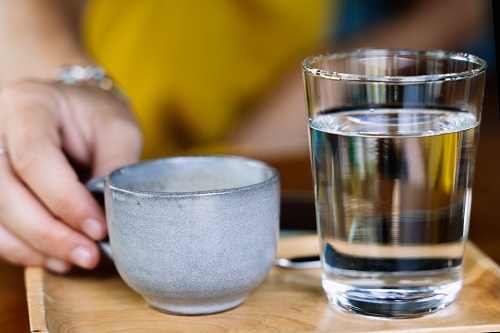Back to Basics: 5 Tips to Lower Fluid Intake

Fluid is a hot topic with people who have chronic kidney disease (CKD) or are on dialysis. As with other aspects of the kidney diet, the recommendation is not one-size-fits-all. Each individual may have a different recommendation for fluid intake, based on their kidney function.
For people on dialysis, the general rule of thumb is to consume no more than 32 ounces (four 8-ounce cups) of fluid per day. However, if a person’s kidneys are still able to produce urine, there may be a more liberal recommendation.
When a person is limiting fluid, they may also struggle with thirst. The below tips may help you manage fluid and thirst.
What Counts as Fluid?
Anything that can melt at room temperature is a fluid. For example: sherbet, popsicles, ice and gelatin. Fluid can also be found in fruits and vegetables, but those levels are hard to measure. When planning meals for the day or week, it’s helpful to keep in mind that some fruits and vegetables are juicier than others.
1. Freeze a Water Bottle
This tip was given to me by a dialysis patient years ago. They would put an 8-ounce or 16-ounce bottle of water in the freezer overnight. In the morning, they would take the bottle out of the freezer and sip on the water as it melted throughout the day. This method can slow down how much water is being consumed. It’s pretty easy to drink a glass of water quickly, especially in the summer months. Waiting for the water to melt helps slow your drinking. Plus, the water stays cold, which can also help with thirst and dry mouth.
Watch this video for a quick demonstration of how to freeze water bottles.
2. Eat Frosted Grapes
Another unique idea is to freeze grapes. This was a tip I learned as an intern in a dialysis center. A patient told me their favorite snack was frozen grapes, which helped with dry mouth. In turn, the cold from the grapes helped to alleviate the thirst so they were not drinking as much fluid. Try DaVita.com’s easy Frosted Grapes recipe, which includes a how-to video. Coating the grapes in flavored gelatin powder gives them a fun flavor and texture!
3. Use a Spray Bottle
A challenge for most people working through a fluid restriction is slowing down how much and how often they drink. Using a small spray bottle can help with dry mouth and control the urge to drink. Small spray bottles that fit in a bag or pocket can be found online, or even in the travel section of a grocery store. They can be filled with plain water or water with a touch of lemon added. I have several patients in my dialysis center who carry a little bottle of water to help with dry mouth.
4. Try Hard Candies and Gum
Another way to manage thirst is to use hard candies or gum. I see a lot of dialysis patients with hard candy, because sucking on these little gems can help the mouth produce saliva, which in turn lowers the desire to drink too much. However, watch out for sugar-free candies or gum. These generally contain sugar alcohols, which can cause gastrointestinal distress in some people (1). Some sugar substitutes and sugar alcohols are also thought to affect gut health, interfering with good bacteria (2).
5. Limit Sodium
We can’t talk about fluid without also talking about sodium or salt intake. Sodium has been shown to increase thirst, which possibly increases the desire to drink more. The body tends to then retain and hold onto this fluid to balance out the amount of sodium in the blood. When someone is on dialysis, they lose the ability to filter out excess fluid or sodium because they no longer make urine. So, limiting sodium intake can also reduce thirst and fluid intake (3).
Hopefully these tips gave you some fresh ideas for controlling fluid intake and dry mouth. What are some of your favorite tips?
References:
- https://www.verywellhealth.com/pros-and-cons-of-sugar-free-candy-1087139. Accessed June 22, 2021
- https://www.ncbi.nlm.nih.gov/pmc/articles/PMC6363527/. Accessed June 22, 2021
- https://www.karger.com/Article/Fulltext/463831. Accessed June 22, 2021
Additional Kidney Diet Resources
Visit DaVita.com and explore these diet and nutrition resources:
- DaVita Food Analyzer
- DaVita Dining Out Guides
- Today’s Kidney Diet Cookbooks
- DaVita Kidney-Friendly Recipes
- Diet and Nutrition Articles
- Diet and Nutrition Videos
- Kidney Smart® Virtual Classes
This article is for informational purposes only and is not a substitute for medical advice or treatment. Consult your physician and dietitian regarding your specific diagnosis, treatment, diet and health questions.

Recent Comments